There’s something absolutely magical about flowering shrubs that bloom all summer—the way they burst into color, transforming ordinary garden corners into vibrant, living tapestries. As someone completely enchanted by blooms, I find these summer-loving shrubs irresistible. They bring not just color, but texture, fragrance, and a sense of life that defines the heart of the warm season.
Flowering shrubs that bloom all summer are more than just eye-catching—they’re garden workhorses that keep your outdoor space alive with energy for months. Whether you’re drawn to the rich purples of butterfly bush or the timeless elegance of hydrangeas, these plants reward you with an endless parade of blossoms. Their long blooming season means you don’t have to constantly replace or replant to keep the garden looking full and fresh.
In this guide, I’ve gathered 47 of the best flowering shrubs that bloom all summer, each with its own unique personality and charm. From heat-tolerant beauties to fragrant magnets for pollinators, there’s something here for every style of garden and every level of gardening experience. Let’s dive into this colorful collection and discover which of these summer-blooming shrubs might become the star of your own backyard paradise.
Types of Flowering Shrubs That Bloom All Summer
Hydrangea (Hydrangea spp.)
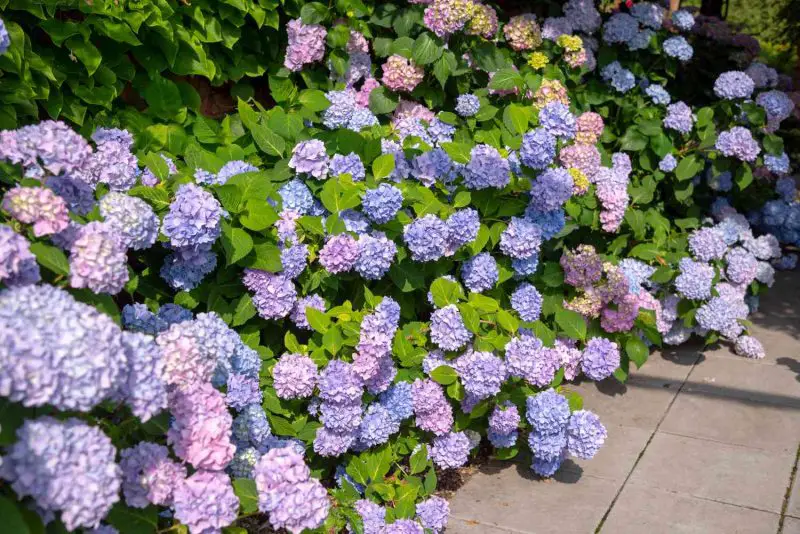
Hydrangeas are among the most beloved flowering shrubs, known for their large, rounded flower heads that bloom in shades of blue, pink, white, or purple depending on the soil pH. Their foliage is lush and green, providing a beautiful backdrop for the blooms. They range in size from compact varieties ideal for small gardens to large, sprawling types perfect for borders or hedges.
These shrubs thrive in well-drained, consistently moist soil and prefer partial shade, although some newer cultivars tolerate full sun in cooler climates. Hydrangeas generally bloom from late spring through summer, and varieties like ‘Endless Summer’ can continue flowering into fall. The USDA hardiness zones for hydrangeas vary by species but typically range from zones 3 to 9.
Care for hydrangeas includes regular watering, especially in dry periods, and a layer of mulch to conserve moisture. Pruning needs vary by type—some bloom on old wood and should be pruned after flowering, while others bloom on new growth and can be pruned in late winter. Feeding them in early spring with a balanced fertilizer promotes healthy blooms.
Butterfly Bush (Buddleja davidii)
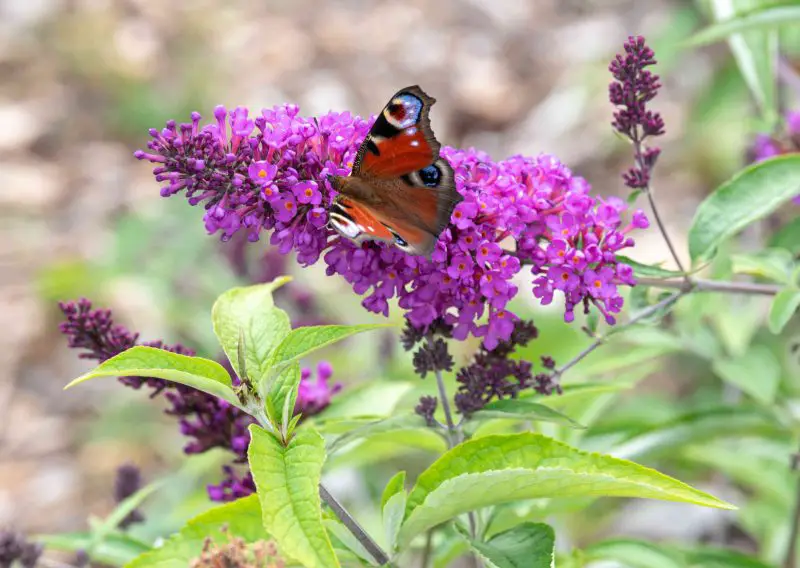
Butterfly bush is a fast-growing deciduous shrub prized for its long, cone-shaped flower clusters that bloom in vibrant shades of purple, pink, blue, white, or yellow. These fragrant flowers are a magnet for butterflies, bees, and hummingbirds, making it an excellent choice for pollinator gardens. Its arching branches and narrow leaves give it a graceful, airy appearance.
This shrub prefers full sun and well-drained soil to flourish. It thrives in USDA hardiness zones 5 through 9 and begins blooming in early summer, continuing through to the first frost. Deadheading spent flowers can encourage even more blooms and prevent the plant from self-seeding too aggressively, especially in warmer climates where it may become invasive.
To care for butterfly bush, provide occasional deep watering during extended dry periods and prune it back heavily in late winter or early spring to encourage vigorous new growth. Fertilizing is generally not necessary if the soil is moderately fertile. In colder zones, mulch the base in winter to protect the roots.
Rose of Sharon (Hibiscus syriacus)
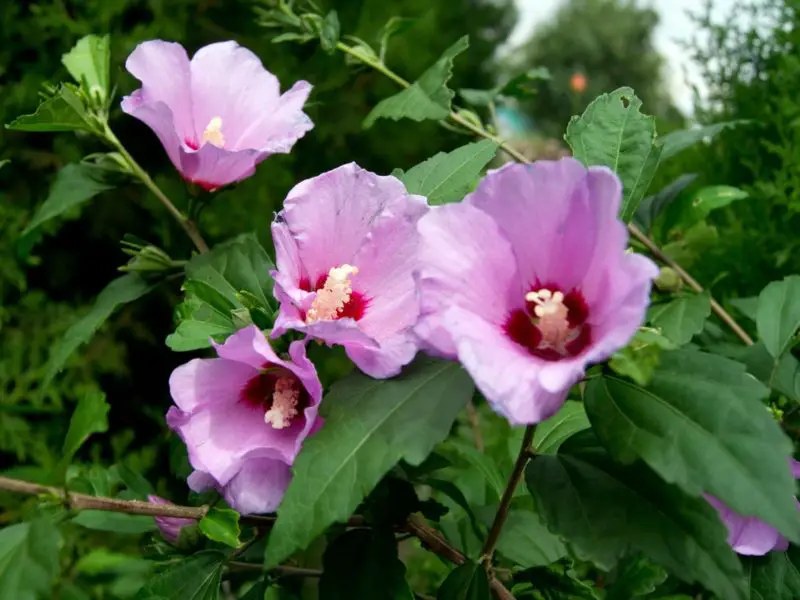
Rose of Sharon is a deciduous shrub in the hibiscus family that produces large, tropical-looking flowers in shades of pink, white, purple, or blue. Its blooms appear from mid-summer into early fall, often when other shrubs have finished flowering. The shrub has an upright, vase-like shape and can be pruned into a small tree or left to grow as a bushy hedge.
This plant thrives in full sun to partial shade and adapts well to various soil types, provided the soil is well-drained. Rose of Sharon grows best in USDA zones 5 through 9. It is drought-tolerant once established, and its late-season blooms provide extended interest in the garden.
To maintain its shape and flowering power, prune Rose of Sharon in early spring before new growth appears. It benefits from a light feeding in spring and an occasional deep watering during hot, dry weather. It is relatively low-maintenance and can reseed, so removing seed pods can help control unwanted spread.
Spirea (Spiraea japonica)
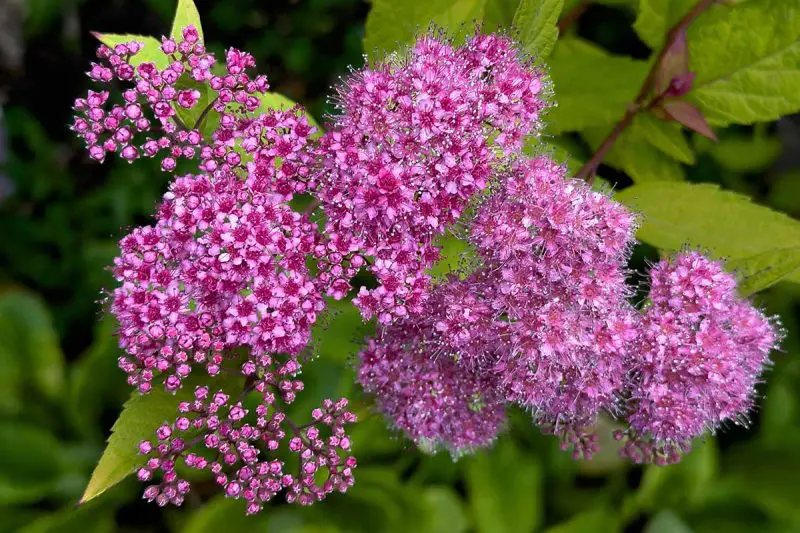
Spiraea japonica is a compact, deciduous shrub known for its profusion of small, clustered flowers in shades of pink, white, or red. It typically has a rounded shape and fine-textured foliage that may turn golden, orange, or red in autumn. Its dense blooms appear in late spring and can continue sporadically into summer, especially if spent flowers are removed.
This shrub thrives in full sun for the best flowering and prefers well-drained soil, although it is tolerant of a variety of conditions. Spiraea grows well in USDA zones 4 to 9 and is often used in borders, mass plantings, or foundation beds. It is very hardy and resists deer and drought once established.
Care for spiraea includes pruning back old stems in early spring to encourage fresh, flowering growth. Deadheading after blooming can prompt a second flush of flowers. Apply a balanced fertilizer in early spring and water during extended dry spells to keep it healthy and productive.
Abelia (Abelia x grandiflora)
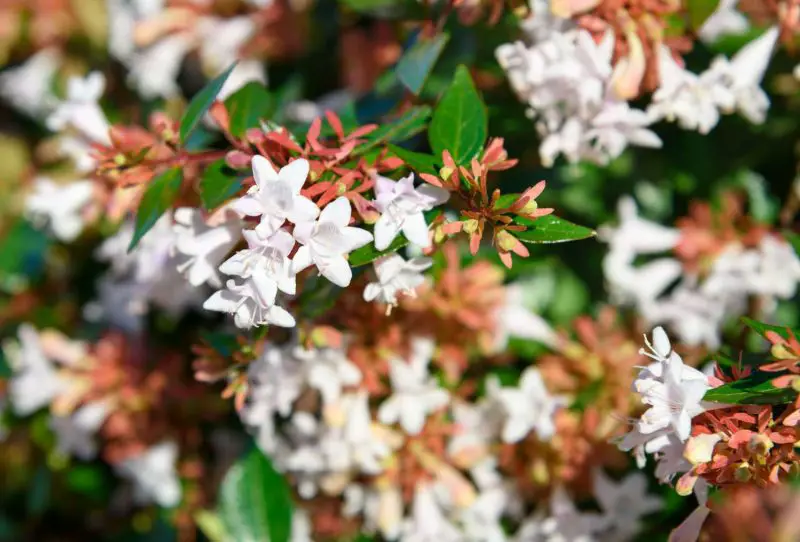
Abelia x grandiflora is a semi-evergreen to deciduous shrub, depending on the climate, that offers long-lasting clusters of small, trumpet-shaped flowers in white, pink, or light lavender. These blooms appear from late spring into fall and are highly attractive to butterflies and bees. The glossy, dark green foliage often turns bronze or purplish in cooler weather, adding year-round interest.
Abelia thrives in full sun to partial shade and prefers moist, well-drained soil. It performs best in USDA hardiness zones 6 through 9 and tolerates heat and humidity well. Its arching branches and manageable size make it ideal for borders, foundation plantings, or even informal hedges.
To care for abelia, prune in early spring to shape the plant and remove any dead wood. Mulch around the base helps retain moisture, and an occasional feeding with a balanced fertilizer can promote healthy growth and blooms. Once established, it is drought-tolerant and relatively pest-free, making it easy to maintain.
Potentilla (Potentilla fruticosa)
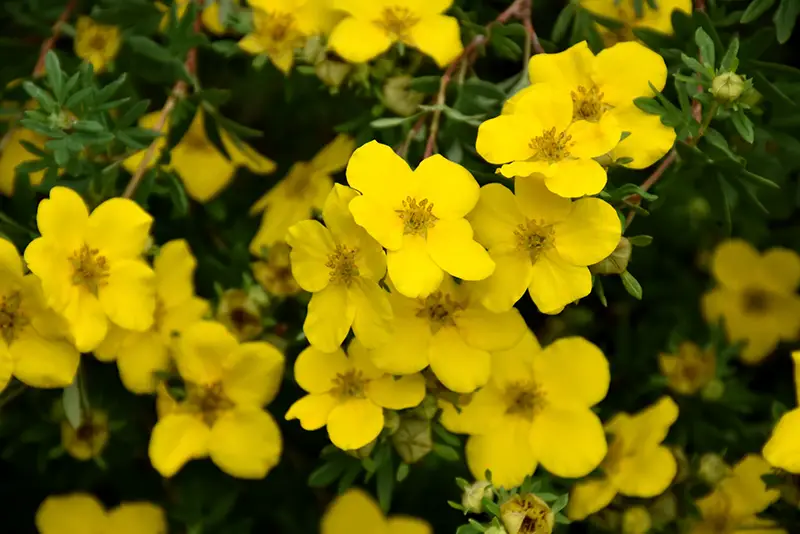
Potentilla fruticosa, commonly known as bush cinquefoil, is a hardy deciduous shrub admired for its cheerful, five-petaled flowers that come in shades of yellow, white, orange, or pink. It has finely textured foliage and a rounded, compact form, making it suitable for low borders and foundation plantings. Blooming from late spring to early fall, Potentilla is a dependable performer throughout the growing season.
This shrub thrives in full sun and prefers well-drained soil, though it tolerates a wide range of soil types, including poor or sandy conditions. It is exceptionally cold-hardy, suitable for USDA zones 2 through 7. Potentilla is drought-tolerant once established, making it a good option for xeriscaping or low-maintenance gardens.
Care for Potentilla is minimal. Light pruning in early spring helps maintain its shape and encourages new growth. Remove any dead or damaged branches as needed. Fertilizing is generally unnecessary in fertile soils, but a light application of balanced fertilizer in spring can support healthier blooms in poorer conditions.
Bluebeard (Caryopteris x clandonensis)
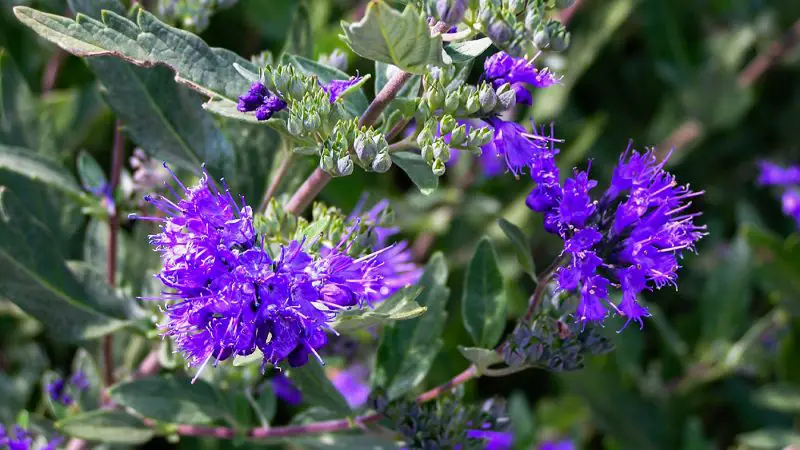
Bluebeard is a compact, deciduous shrub that produces stunning clusters of deep blue or purple flowers late in the summer when few other shrubs are in bloom. Its silvery-green foliage and aromatic nature make it a standout in mixed borders and pollinator gardens. It is particularly attractive to bees, butterflies, and other beneficial insects.
Bluebeard thrives in full sun and prefers well-drained soil with moderate fertility. It performs best in USDA zones 5 through 9. This drought-tolerant shrub is ideal for hot, dry locations and can handle urban conditions such as pollution or poor soil, provided drainage is adequate. Its flowering period extends from midsummer through early fall.
For best results, prune Bluebeard back to about 6–12 inches from the ground in late winter or early spring, as it blooms on new wood. Avoid excessive fertilization, which can lead to weak, leggy growth. Occasional watering during dry spells and mulching around the base will help retain moisture and keep the plant healthy.
Knock Out Roses (Rosa ‘Knock Out’ Series)
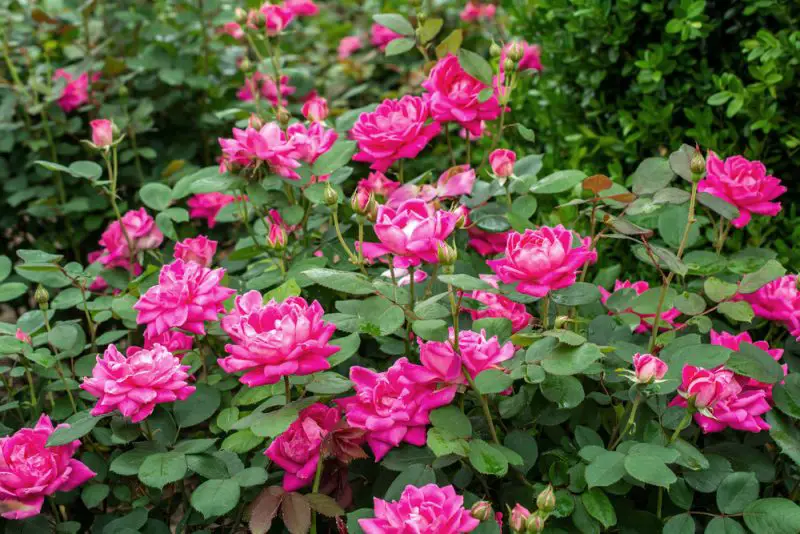
Knock Out roses are a group of shrub roses known for their exceptional disease resistance, repeat blooming, and low maintenance needs. They produce an abundance of blooms in red, pink, yellow, or white from late spring until the first frost. The foliage is glossy and deep green, adding to the shrub’s appeal even when not in full bloom.
These roses thrive in full sun and well-drained soil and are adaptable to various garden settings, including containers, hedges, or mass plantings. Knock Out roses grow well in USDA zones 5 through 10. They are especially valued for their resistance to black spot, mildew, and other common rose ailments, making them a reliable choice for gardeners of all experience levels.
To care for Knock Out roses, prune in early spring when new growth begins, cutting back about one-third to shape the shrub and encourage new blooms. Deadheading is optional but can promote a tidier appearance. Apply a balanced fertilizer in spring and water regularly during dry periods, especially in hotter climates.
Weigela (Weigela florida)
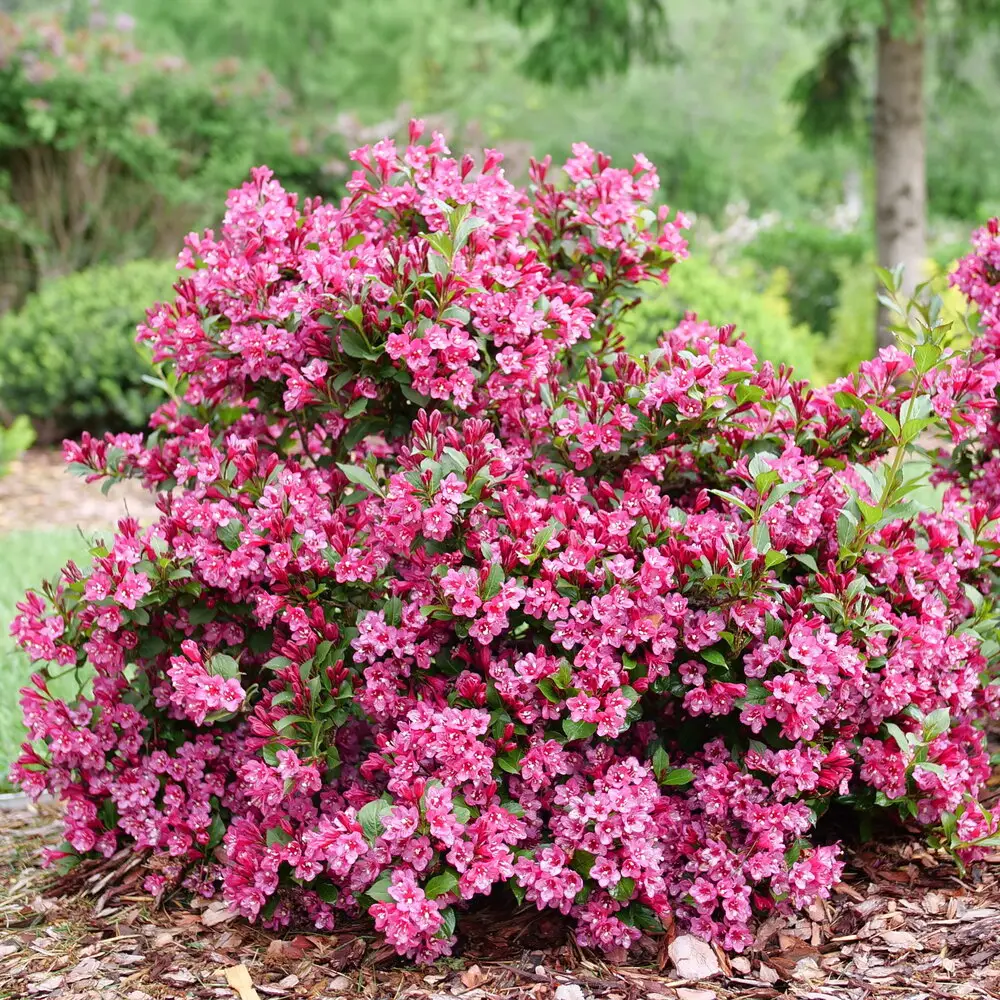
Weigela is a deciduous shrub celebrated for its trumpet-shaped flowers that bloom in vibrant shades of pink, red, or white. Its arching branches and lush green or variegated leaves provide beautiful contrast to the profuse blooms that appear in late spring and may repeat throughout the summer. Weigela also attracts hummingbirds and butterflies.
This shrub performs best in full sun but can tolerate light shade, especially in hotter climates. It prefers moist, well-drained soil and thrives in USDA zones 4 through 8. While older varieties may have a single bloom period, newer cultivars have been bred to bloom repeatedly throughout summer.
Weigela requires minimal maintenance. Prune after the first bloom to shape the plant and encourage more flowers. Fertilize in early spring with a balanced, slow-release fertilizer. Water regularly during dry spells, especially in the first growing season, to help establish strong roots.
St. John’s Wort (Hypericum calycinum)
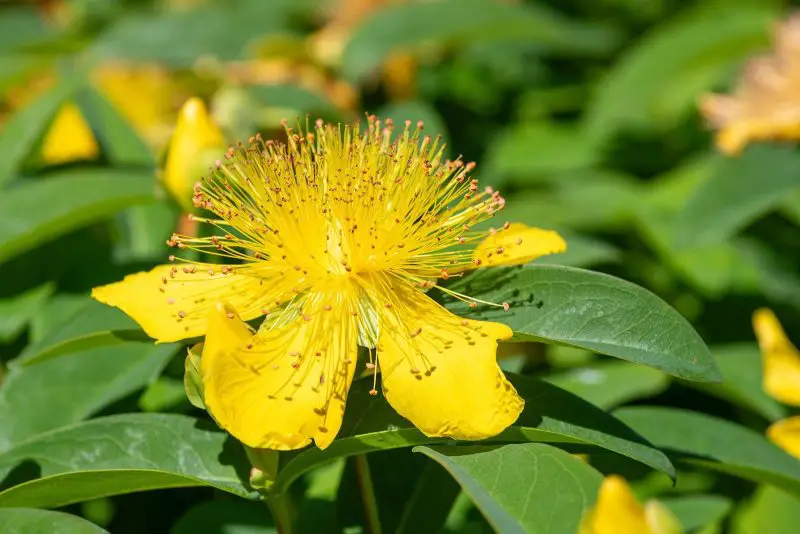
St. John’s Wort is a low-growing, semi-evergreen shrub valued for its bright yellow, star-like flowers and attractive blue-green foliage. It blooms profusely from early summer into fall, creating a cheerful ground cover or border plant. The flowers are followed by ornamental seed pods that provide additional interest.
This hardy shrub thrives in full sun to partial shade and tolerates a variety of soil types, including poor or rocky soils. It performs well in USDA zones 5 through 9 and is particularly useful for erosion control on slopes or in mass plantings. It is drought-tolerant once established and resists deer and pests.
Care for St. John’s Wort is straightforward. Cut back the stems in early spring to encourage fresh, compact growth. Mulch to retain moisture and suppress weeds. While it doesn’t require frequent fertilization, a light feeding in spring can enhance blooming. Regular watering during hot, dry periods will keep it lush and vibrant.
Crape Myrtle (Lagerstroemia indica)
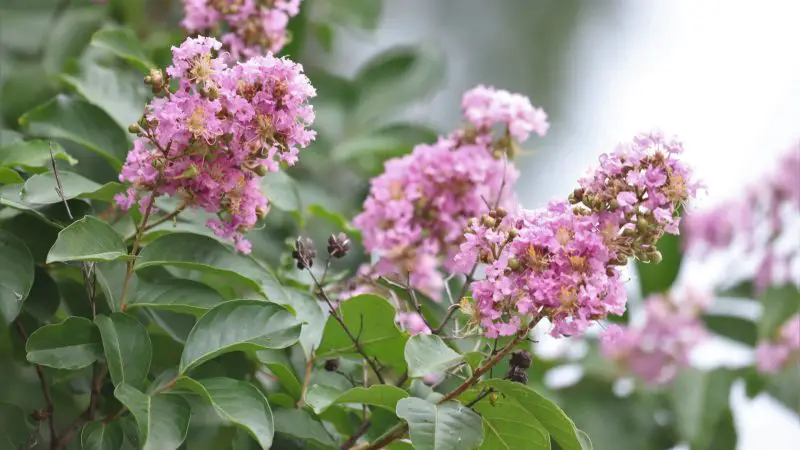
Crape Myrtle is a deciduous flowering shrub or small tree known for its striking, long-lasting blooms that range in color from pink, red, purple, to white. Its flowers appear in large, crinkled clusters starting in mid to late summer and may continue into fall. In addition to its vibrant flowers, Crape Myrtle offers attractive peeling bark and brilliant fall foliage, adding year-round interest to landscapes.
This plant thrives in full sun and well-drained soil, performing best in USDA zones 6 through 10. It appreciates warm climates and tolerates heat and drought once established. Crape Myrtle is ideal for urban settings, borders, or as a specimen plant due to its upright growth habit and ornamental appeal.
To maintain shape and encourage profuse blooming, prune in late winter or early spring before new growth begins. Avoid heavy pruning, often called “crape murder,” which can damage the plant’s natural form. Water regularly during dry periods and apply mulch to conserve soil moisture. A slow-release fertilizer in spring helps promote healthy blooms.
Glossy Abelia (Abelia chinensis)
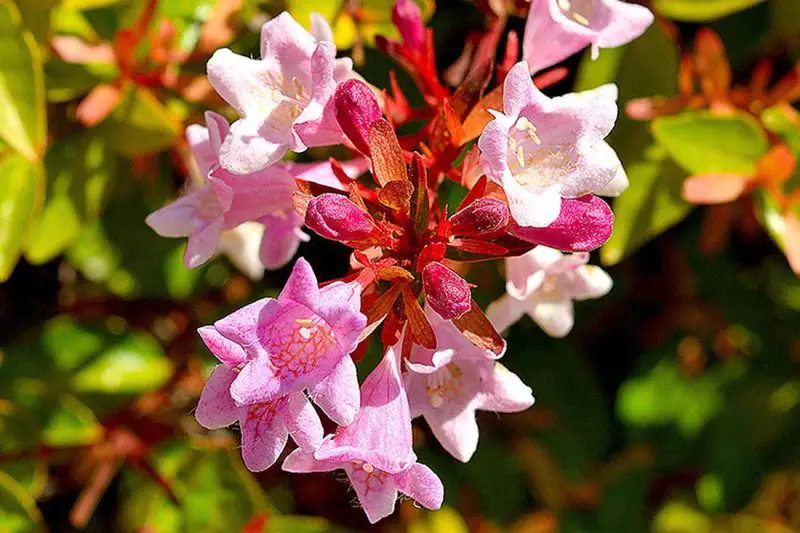
Glossy Abelia is a semi-evergreen to deciduous shrub with a graceful arching habit and small, glossy leaves that turn bronze or purplish in fall. From late spring through summer, it produces clusters of tubular, fragrant flowers in shades of white or pale pink, attracting butterflies and hummingbirds to the garden.
This shrub grows best in full sun to partial shade and adapts to a variety of soils, provided they are well-drained. Glossy Abelia is hardy in USDA zones 6 through 9 and is valued for its extended blooming period and ability to thrive with minimal care. It works well in borders, hedges, or foundation plantings.
Minimal pruning is required, though shaping in late winter or early spring can encourage a denser form. Water regularly during the first growing season to establish roots, then reduce frequency once the plant is established. A balanced fertilizer in spring can support vigorous growth and flowering.
Gardenia (Gardenia jasminoides)
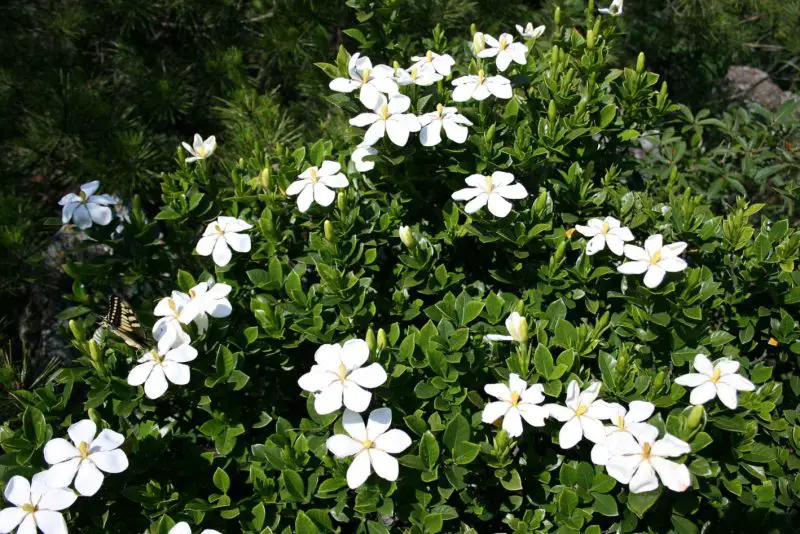
Gardenia jasminoides, or Cape Jasmine, is beloved for its fragrant, creamy white flowers and glossy, dark green foliage. The blooms, which resemble roses, appear from late spring through summer and sometimes into early fall, depending on the climate. The strong, sweet scent of the flowers makes Gardenia a prized shrub for sensory gardens and entryways.
This evergreen shrub prefers partial shade and rich, acidic, well-drained soil with consistent moisture. Gardenia is best suited to USDA zones 8 through 11, though some cold-hardy varieties can survive in zone 7. It performs well in humid environments and requires protection from cold winds and frost in cooler regions.
To care for Gardenia, maintain even soil moisture and mulch around the base to conserve water and regulate soil temperature. Prune lightly after blooming to shape the shrub. Fertilize with an acid-loving plant food in early spring and again in midsummer to support healthy foliage and flower production.
Dwarf Fothergilla (Fothergilla gardenii)
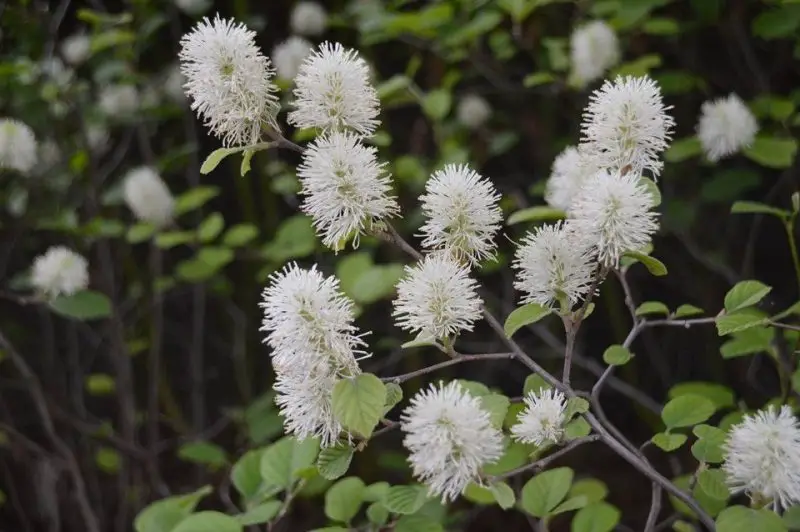
Dwarf Fothergilla is a compact, deciduous shrub known for its bottlebrush-like white flowers that bloom in early to mid-spring before the leaves emerge. The fragrant blooms are followed by attractive blue-green foliage that turns vibrant shades of red, orange, and yellow in the fall, making it a multi-seasonal plant.
This shrub grows best in full sun to partial shade and thrives in moist, acidic, well-drained soil. Dwarf Fothergilla is hardy in USDA zones 4 through 8 and is ideal for smaller gardens, woodland edges, or mixed borders. It tolerates shade well but produces more vibrant fall color with increased sunlight.
Little maintenance is required for Dwarf Fothergilla. Prune after flowering if shaping is needed. Regular watering, especially during dry spells, will help keep the plant healthy. Mulching helps retain soil moisture and suppress weeds. Avoid alkaline soils, which can lead to chlorosis in the foliage.
Summersweet (Clethra alnifolia)
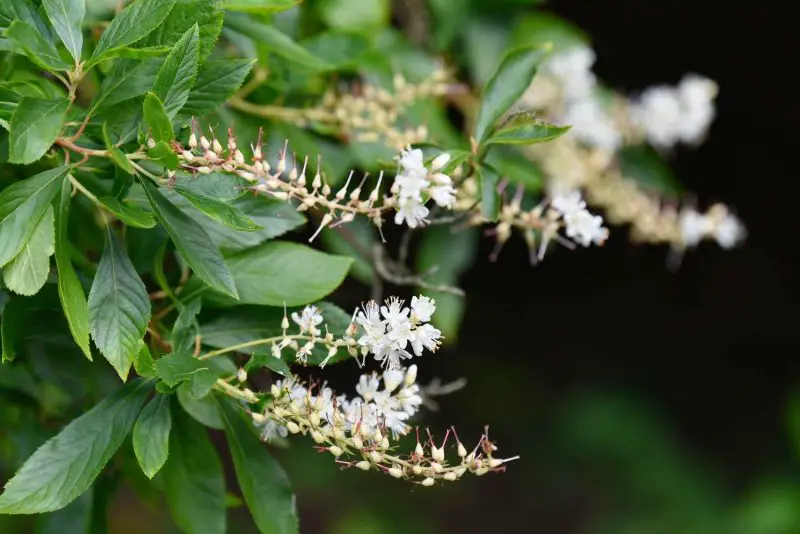
Summersweet, also known as Sweet Pepperbush, is a deciduous shrub appreciated for its fragrant, bottlebrush-shaped flower spikes that bloom in midsummer. The blooms come in white or pale pink and attract bees, butterflies, and hummingbirds. Its bright green foliage turns golden yellow in fall, providing late-season color.
This shrub prefers partial shade to full sun and moist, acidic, well-drained soil. Summersweet is native to wetland areas and is well-suited to USDA zones 3 through 9. It tolerates clay soil and is ideal for rain gardens, woodland settings, or along streams and ponds.
Summersweet requires minimal care. Prune in late winter or early spring to maintain shape and size. Mulch annually to retain soil moisture, and water consistently, especially during prolonged dry spells. Fertilization is typically unnecessary unless the plant is growing in poor soil.
Shrub Rose (Rosa rugosa)
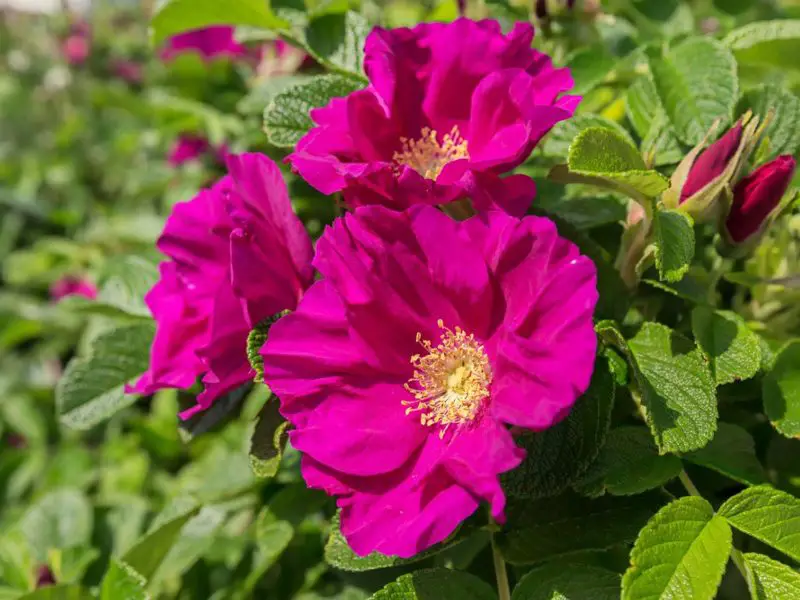
Rosa rugosa, commonly known as Shrub Rose, is a hardy, disease-resistant rose species prized for its fragrant, wrinkled foliage and abundant blooms. The flowers appear from late spring through summer in shades of pink, white, or magenta, often followed by bright red rose hips that add ornamental value in fall and winter. Its dense, thorny growth makes it an excellent natural hedge or barrier.
This shrub thrives in full sun and well-drained soils and is tolerant of poor, sandy, or coastal soils, making it a favorite for seaside gardens. Shrub Rose grows well in USDA zones 3 through 9, displaying impressive cold tolerance. It performs best with regular watering but can endure drought once established.
Minimal pruning is needed—simply remove dead or damaged wood in early spring. Apply mulch to retain soil moisture and suppress weeds, and feed with a balanced fertilizer in spring for robust flowering. Due to its resilience and continuous bloom cycle, Shrub Rose is a low-maintenance choice for pollinator-friendly gardens.
Mock Orange (Philadelphus coronarius)
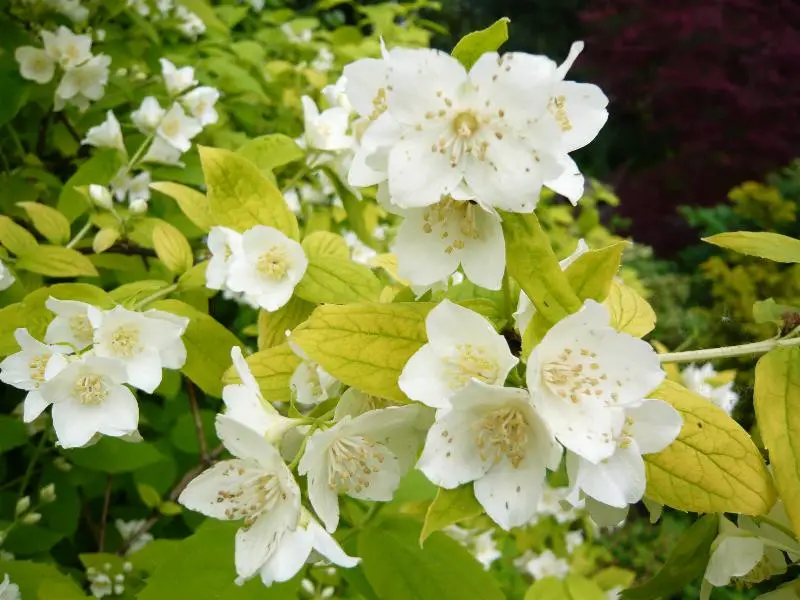
Mock Orange is a deciduous flowering shrub loved for its intensely fragrant, creamy white flowers that resemble orange blossoms. Blooming in late spring to early summer, these large, showy flowers grow in clusters and are often used in fragrance gardens. The shrub has arching branches and dark green leaves that create a graceful silhouette.
This plant grows well in full sun to partial shade and tolerates a range of soil types, preferring moist, well-drained soil. It is hardy in USDA zones 4 through 8 and is adaptable to various climates. Mock Orange is excellent as a specimen plant, in mixed borders, or as part of a cottage garden.
To maintain a neat shape and encourage new growth, prune immediately after flowering. Remove old stems at the base to rejuvenate the plant. Water during dry periods, especially in the first few years, and mulch annually to protect roots and improve soil quality. Minimal fertilization is needed unless the soil is particularly poor.
Hibiscus moscheutos (Hardy Hibiscus)
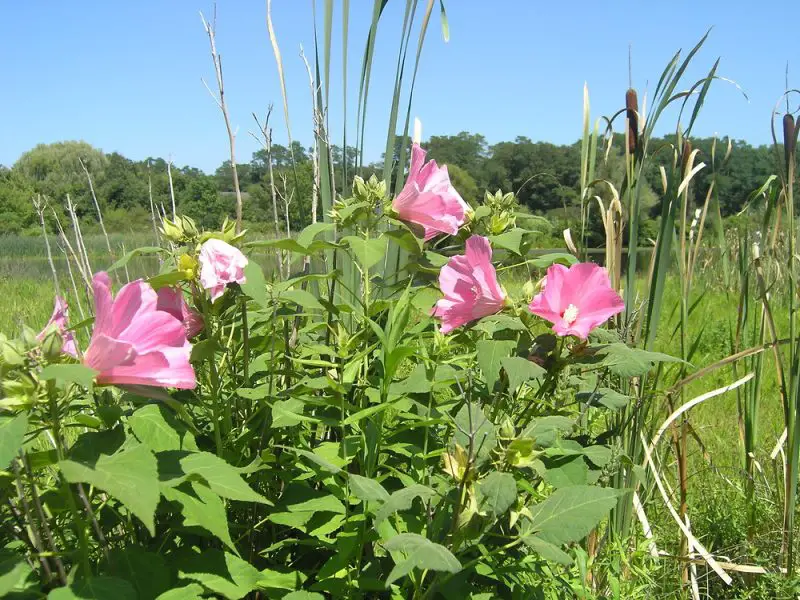
Hibiscus moscheutos, or Hardy Hibiscus, is a show-stopping perennial shrub known for its enormous, tropical-looking flowers that can reach up to 12 inches across. Blooming from midsummer through fall, the blossoms come in shades of white, pink, red, and bi-color combinations, often with a dramatic central eye.
This plant thrives in full sun and rich, consistently moist soil and is well-suited to USDA zones 5 through 9. Hardy Hibiscus prefers a sheltered location with ample room to grow, as mature plants can reach 3 to 6 feet tall and wide. It is often used in borders, near water features, or in rain gardens.
Cut back stems to the ground in late fall or early spring as the plant dies back to the root each winter. Regular watering is crucial during hot months to support its large flowers. Apply a balanced fertilizer in spring and again midseason. While it emerges late in spring, it quickly fills out and becomes a dramatic focal point.
Caryopteris incana (Blue Mist Shrub)
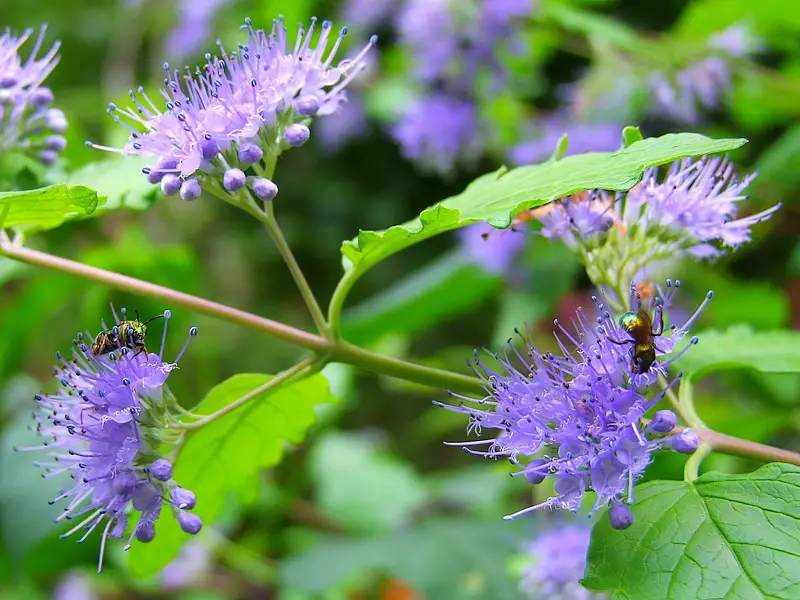
Caryopteris incana, also known as Blue Mist Shrub or Bluebeard, is a deciduous shrub with silvery green leaves and clusters of airy, lavender-blue flowers that bloom in late summer into fall. The flowers are highly attractive to bees and butterflies, providing a valuable nectar source when many other plants have stopped blooming.
Blue Mist Shrub grows best in full sun and well-drained soil, thriving in USDA zones 5 through 9. It is drought-tolerant once established and prefers slightly alkaline soils. With a compact, rounded form, this shrub is ideal for perennial borders, rock gardens, or pollinator-friendly landscapes.
Prune hard in early spring to encourage fresh growth and dense flowering. Avoid overwatering, and use mulch to conserve moisture in dry periods. Minimal fertilization is needed, but a light application in spring can help promote vigorous blooming. Its late-season flowers and low-maintenance habit make it a garden favorite.
Callicarpa americana (American Beautyberry)
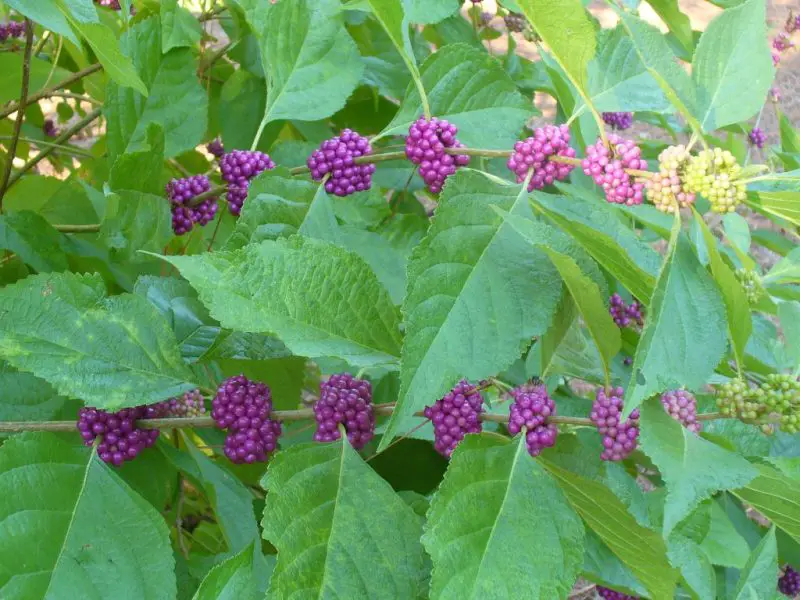
American Beautyberry is a deciduous shrub known for its striking clusters of vibrant purple berries that appear in late summer and persist into fall. While it blooms with small pink to lavender flowers in early to midsummer, it’s the ornamental berries that steal the show, drawing birds and adding bold color to the landscape.
This shrub grows well in full sun to partial shade and prefers moist, well-drained soils but tolerates dry conditions once established. It is native to the southeastern United States and hardy in USDA zones 6 through 10. American Beautyberry is often used in naturalized plantings, woodland gardens, and wildlife-friendly areas.
Prune in late winter or early spring to maintain a tidy form and encourage strong new growth. It requires little maintenance aside from occasional watering during dry periods. Fertilizing is rarely necessary unless the soil is nutrient-poor. Mulching helps conserve moisture and prevent weed growth around the base.
Tamarix ramosissima (Salt Cedar or Tamarisk)
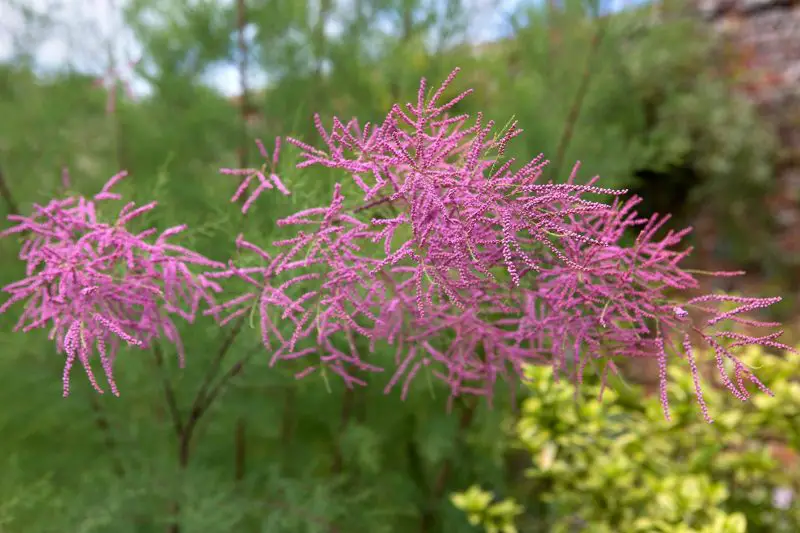
Tamarix ramosissima, commonly called Salt Cedar or Tamarisk, is a deciduous shrub or small tree known for its feathery, bluish-green foliage and plume-like sprays of small pink flowers that bloom from mid to late summer. Its airy structure and showy blossoms give it a soft, cloud-like appearance in the landscape. It also features reddish-brown bark and flexible branches that add winter interest.
This shrub thrives in full sun and well-drained soils and is highly tolerant of drought, heat, wind, and even saline or alkaline soils. It is hardy in USDA zones 3 through 8, making it a good choice for arid and semi-arid regions. Due to its ability to spread aggressively in some areas, especially near waterways, it is considered invasive in parts of the U.S.
Salt Cedar requires little maintenance once established. Pruning can help control its shape and size, ideally done in early spring before new growth begins. While it does not demand regular feeding, occasional fertilization can boost growth in nutrient-poor soils. Always check local guidelines before planting, as it may be restricted in certain regions.
Deutzia (Deutzia gracilis)
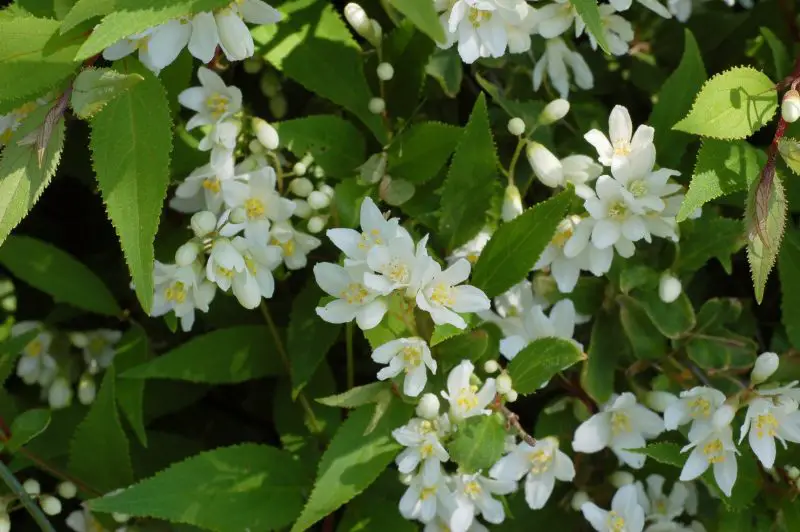
Deutzia gracilis is a graceful, compact deciduous shrub with arching branches and a profusion of small, star-shaped white flowers that bloom in late spring to early summer. The foliage is medium green and may turn bronze or reddish in autumn, adding multi-season appeal to the garden. The flowers form in clusters and are lightly fragrant.
This low-maintenance shrub thrives in full sun to partial shade and prefers moist, well-drained soils. It performs well in USDA zones 5 through 8 and is especially suited to borders, foundation plantings, and informal hedges. Its neat growth habit and reliability make it a favorite in cottage and woodland gardens.
Prune immediately after flowering to maintain shape and remove spent blooms. Deutzia benefits from occasional thinning to encourage air circulation and new growth. Regular watering during dry spells is beneficial, though it can tolerate short periods of drought once established. A layer of mulch helps retain soil moisture and suppress weeds.
Lavatera (Tree Mallow)
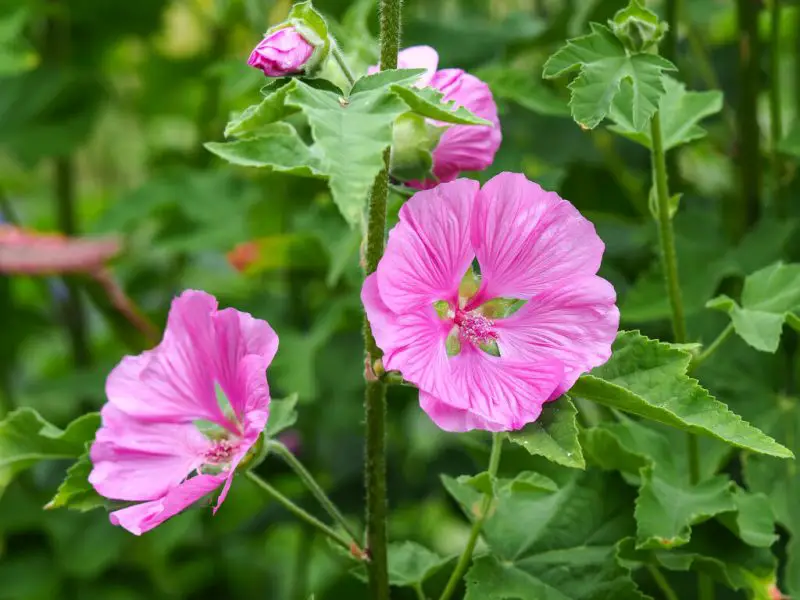
Lavatera, or Tree Mallow, is a fast-growing, semi-woody shrub that produces an abundance of hibiscus-like flowers in shades of pink, white, or purple throughout the summer months. The blooms are attractive to pollinators, and the lobed, soft green leaves give the plant a lush, bushy appearance. It is especially valued for its long bloom time and rapid growth.
Tree Mallow thrives in full sun and prefers well-drained, sandy or loamy soils. It is hardy in USDA zones 6 through 9 and does best in sheltered locations protected from harsh winter winds. It is ideal for coastal gardens, mixed borders, or informal hedging due to its salt tolerance and floriferous habit.
To encourage continuous blooming, deadhead spent flowers regularly. Prune in early spring to remove winter damage and promote dense growth. Tree Mallow needs moderate watering, particularly during dry periods, but is generally drought-tolerant once established. Mulching around the base can help conserve moisture and protect roots.
Escallonia (Escallonia spp.)
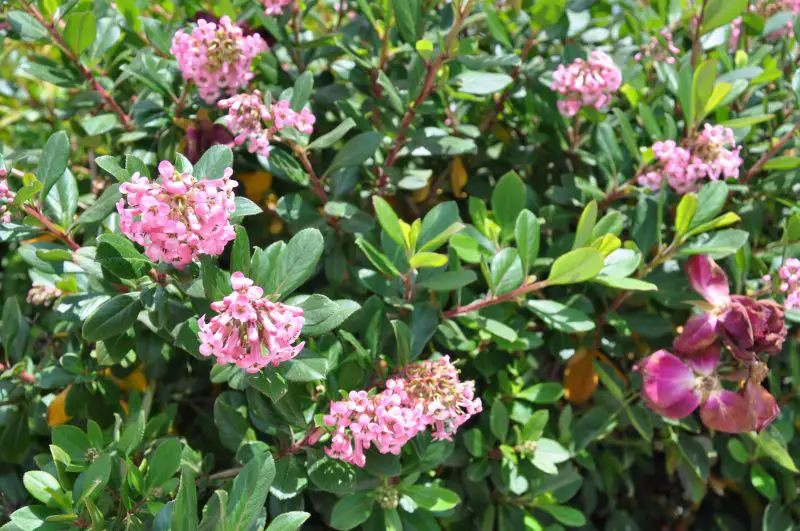
Escallonia is a versatile evergreen or semi-evergreen shrub featuring glossy, dark green foliage and clusters of tubular flowers that appear in shades of pink, red, or white during late spring through summer. The flowers are highly attractive to bees and hummingbirds, and the foliage releases a faintly spicy aroma when brushed.
It thrives in full sun and prefers well-drained soils, performing well in USDA zones 7 through 10. Escallonia is often used for hedging, coastal plantings, or mixed shrub borders due to its salt and wind tolerance. It can be shaped easily, making it ideal for both formal and informal garden designs.
Light pruning after flowering will help maintain a compact shape and encourage additional blooms. Water regularly during establishment, then reduce watering as the plant becomes more drought-tolerant. Apply a balanced fertilizer in spring for optimal flowering. Mulching helps keep roots cool and soil evenly moist.
Oleander (Nerium oleander)

Oleander is a robust, evergreen shrub known for its lush, dark green lance-shaped leaves and prolific clusters of fragrant, five-petaled flowers. Blooming from late spring through summer—and often into fall—the flowers come in colors like white, pink, red, and yellow. It is a popular choice in warm climates for its vibrant appearance and low maintenance needs.
This sun-loving plant thrives in USDA zones 8 through 11 and adapts well to a range of soil types, including poor or sandy soils. Oleander is drought-tolerant once established and highly resistant to salt and heat, making it ideal for coastal areas, roadside plantings, or xeriscaping projects.
Prune in late winter or early spring to maintain shape and remove dead wood. Oleander benefits from occasional deep watering and light feeding during the growing season. Important note: all parts of this plant are highly toxic if ingested, so it should be planted with caution in areas accessible to children or pets.
Mexican Bush Sage (Salvia leucantha)

Mexican Bush Sage is a striking perennial shrub known for its long, arching stems lined with fuzzy, purple or violet-blue flower spikes that bloom from mid-summer into fall. The soft, silvery-green foliage adds a lush texture to garden beds and contrasts beautifully with the vibrant blossoms. Its flowers are beloved by hummingbirds, butterflies, and bees, making it an excellent pollinator plant.
This sun-loving shrub thrives in USDA zones 8 through 11 and prefers well-drained soil, though it can tolerate drought once established. It does best in full sun and benefits from a warm, sheltered location. In cooler climates, it can be grown as an annual or overwintered indoors.
To keep Mexican Bush Sage looking its best, prune it back in early spring to encourage bushier growth and more blooms. Water moderately, allowing the soil to dry between waterings. While it is low-maintenance, applying mulch can help retain soil moisture and suppress weeds.
Russian Sage (Perovskia atriplicifolia)
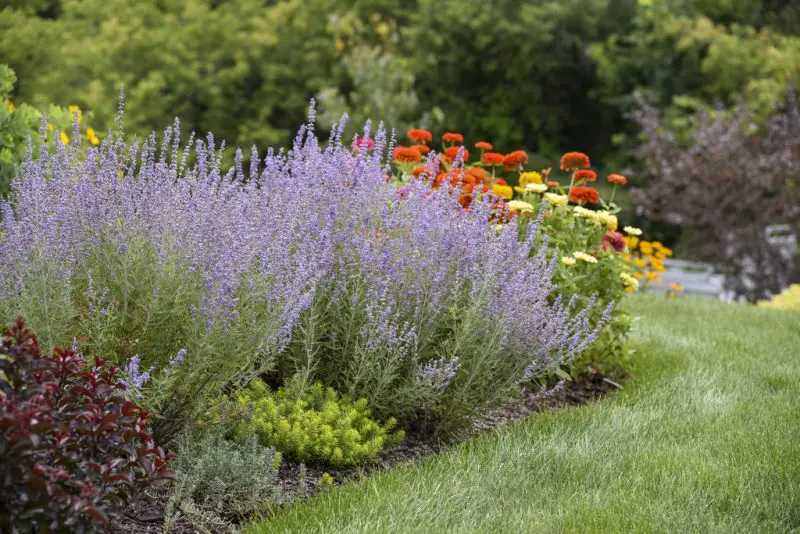
Russian Sage is a woody, drought-tolerant shrub admired for its tall, airy stems covered with silvery foliage and small lavender-blue flowers that bloom from mid-summer through fall. The blossoms form in long, plume-like clusters and create a cloud of color above the soft-textured foliage. Its aromatic leaves add an extra sensory dimension when brushed or crushed.
Thriving in USDA zones 4 through 9, Russian Sage performs best in full sun and well-drained soils. It is highly heat and drought tolerant, making it a perfect choice for xeriscapes, rock gardens, or sunny borders. It resists deer and attracts a variety of pollinators, especially bees.
Cut back stems to about 12–15 inches in late winter or early spring to promote dense, healthy growth. Russian Sage requires minimal watering once established and can benefit from light mulching. Avoid overwatering or rich soils, as these can lead to leggy growth or root rot.
Dwarf Althea (Compact Rose of Sharon hybrids)
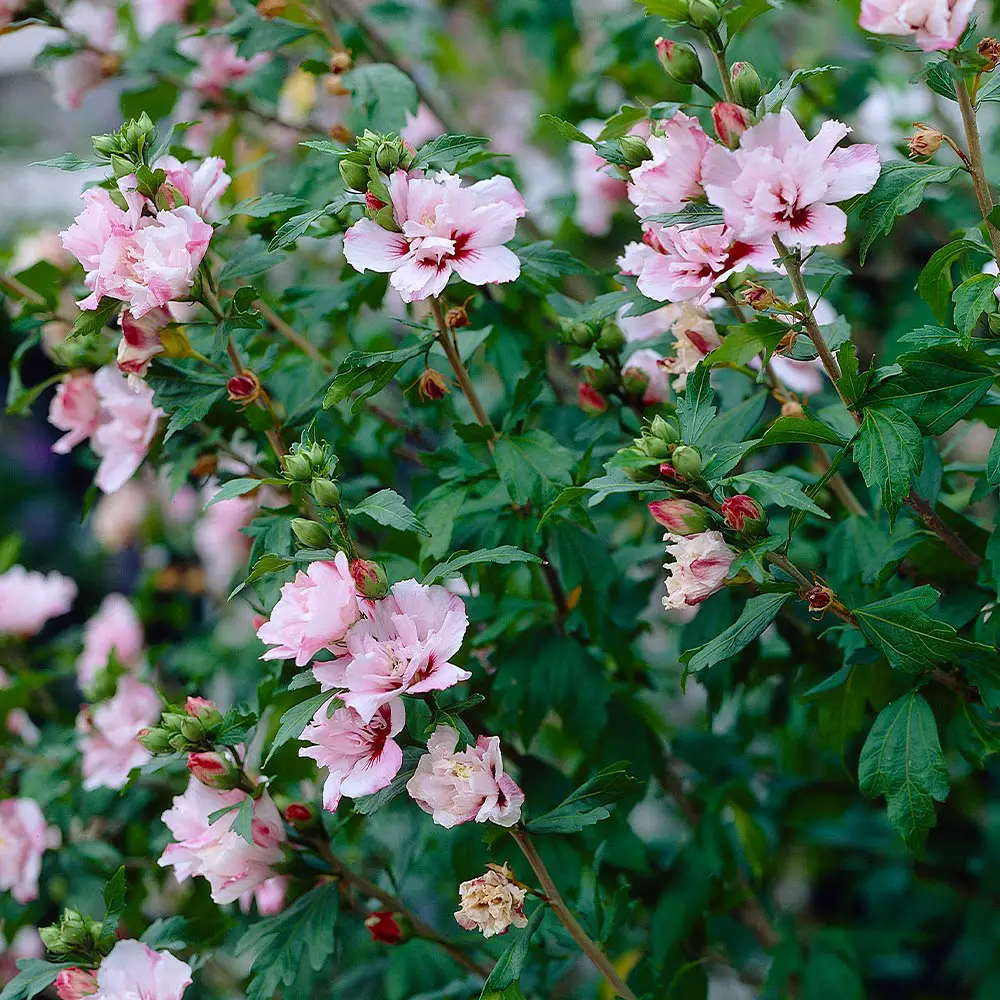
Dwarf Althea is a compact version of the Rose of Sharon, offering the same hibiscus-like flowers in shades of pink, blue, lavender, or white with a much more manageable size. These hybrids bloom from midsummer into fall, bringing continuous color to small gardens and patio containers. The blossoms often feature a darker throat and attract hummingbirds and butterflies.
These shrubs thrive in USDA zones 5 through 9 and prefer full sun to light shade. They tolerate a variety of soil types, including clay and sandy soils, as long as drainage is adequate. Their smaller size makes them ideal for foundation plantings, borders, and urban gardens.
Minimal pruning is needed beyond occasional shaping and removal of old blooms. Water regularly during the first growing season to establish a strong root system, then reduce frequency. These compact shrubs are generally pest-resistant and require little fertilization, making them a great low-maintenance choice.
Hebe (Hebe spp.)
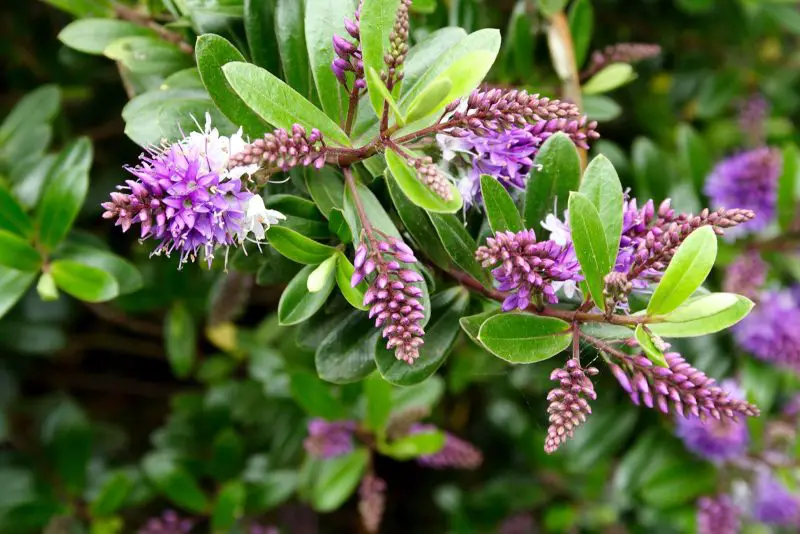
Hebe is a versatile evergreen shrub with glossy green to variegated leaves and charming flower spikes that appear in shades of white, purple, pink, or blue. Many varieties bloom from late spring through summer, with some extending into early fall. The dense foliage and rounded form add structure and texture to the garden even when not in bloom.
Hebes thrive in USDA zones 7 through 10, preferring full sun to partial shade and well-drained soil. They are particularly suited to coastal gardens due to their tolerance for wind and salt spray. Their compact size and tidy habit make them excellent for edging, rock gardens, or container displays.
Prune lightly after flowering to maintain shape and encourage new blooms. Avoid heavy pruning into old wood, as regrowth may be slow. Hebes benefit from regular watering during dry spells and appreciate mulch to keep roots cool and moist. In colder zones, winter protection may be necessary.
Bougainvillea (in shrub form)

Bougainvillea, when trained as a shrub, offers a burst of vivid color throughout the warm months thanks to its papery bracts that surround small, white true flowers. These bracts come in brilliant hues such as magenta, purple, red, orange, or white and provide non-stop color from late spring to fall. The shrub form is typically kept compact through pruning and is ideal for sunny borders or containers.
This heat-loving plant thrives in USDA zones 9 through 11 and performs best in full sun with well-drained, slightly acidic soil. Bougainvillea is extremely drought-tolerant once established but blooms best with moderate, consistent watering. In cooler regions, it can be grown in containers and brought indoors during winter.
Prune regularly to maintain shape and promote bushier growth and heavier blooming. Fertilize lightly during the growing season with a low-nitrogen blend. Bougainvillea appreciates drying out slightly between waterings, and care should be taken when handling due to its thorny stems.
Barberry ‘Golden Rocket’ (Berberis thunbergii)
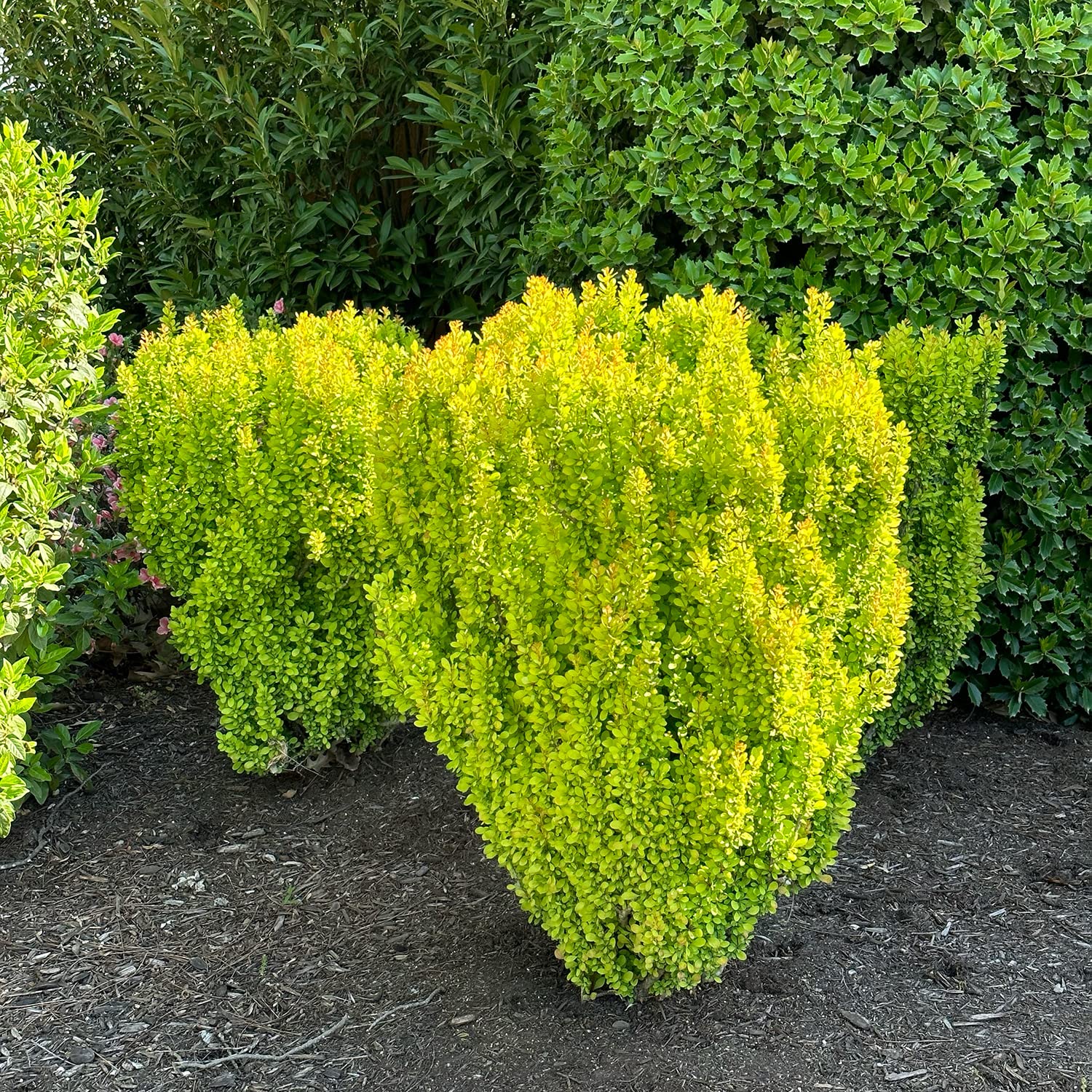
‘Golden Rocket’ Barberry is a striking deciduous shrub known for its narrow, upright growth habit and bright chartreuse-yellow foliage. In late spring to early summer, it may produce small, inconspicuous yellow flowers followed by red berries in fall, which are attractive to birds. Its vibrant leaves add bold color to landscapes throughout the growing season, turning a rich golden-orange in autumn.
This cultivar grows well in USDA zones 4 through 8 and prefers full sun to partial shade. It thrives in well-drained soil and is tolerant of urban conditions, drought, and deer. Its upright, columnar shape makes it ideal for narrow spaces, borders, or as a vertical accent in mixed plantings.
Care for ‘Golden Rocket’ involves minimal pruning to maintain its form, typically done in late winter or early spring. It is a low-maintenance plant that does not require frequent watering once established. Be aware that in some states, certain barberry species are considered invasive, so it’s essential to check local regulations before planting.
Lantana (Lantana camara)
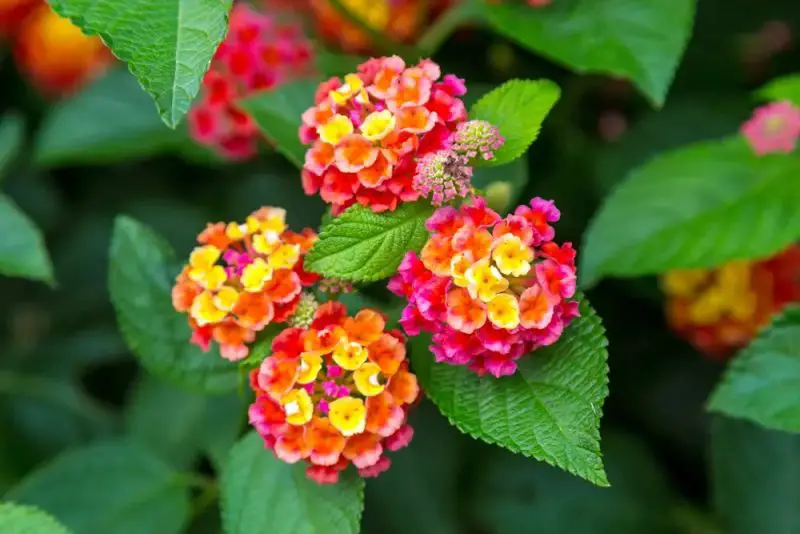
Lantana camara is a woody shrub in warmer climates, prized for its clusters of bright, multi-colored flowers that bloom continuously from late spring through fall. The small tubular flowers attract butterflies, bees, and hummingbirds, and the foliage has a pungent scent when brushed. Colors often include combinations of red, orange, yellow, pink, and purple, creating a vibrant display all summer.
This heat- and drought-tolerant shrub thrives in USDA zones 9 through 11, though it is often grown as an annual in cooler regions. It prefers full sun and well-draining soil and is especially popular in xeriscapes, pollinator gardens, and containers due to its toughness and vivid blooms.
Lantana requires little maintenance—just occasional deadheading to prolong flowering and pruning to shape the plant or remove woody stems. Water moderately until established, then only during extended dry periods. In frost-prone areas, it can be overwintered indoors or grown in containers for seasonal color.
Cape Honeysuckle (Tecomaria capensis)
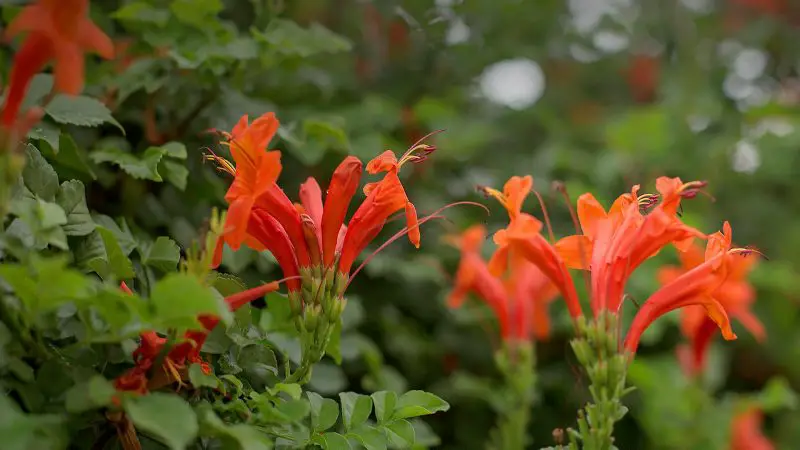
Cape Honeysuckle is a semi-evergreen shrub or sprawling vine known for its brilliant trumpet-shaped flowers in shades of red, orange, or yellow that bloom from summer into fall. These nectar-rich flowers are irresistible to hummingbirds and butterflies. The lush green foliage and vigorous growth make it an excellent choice for covering fences, trellises, or forming informal hedges.
Best suited for USDA zones 9 through 11, Cape Honeysuckle thrives in full sun to partial shade and tolerates a wide range of soil types, provided drainage is good. It is especially valuable in warm, coastal, or tropical landscapes and grows quickly under ideal conditions.
Regular pruning helps maintain its shape and encourages more blooms. Cape Honeysuckle is relatively drought-tolerant once established and only needs occasional watering. It benefits from mulching and a balanced fertilizer in spring to promote healthy growth and extended blooming.
Smoke Bush (Cotinus coggygria)
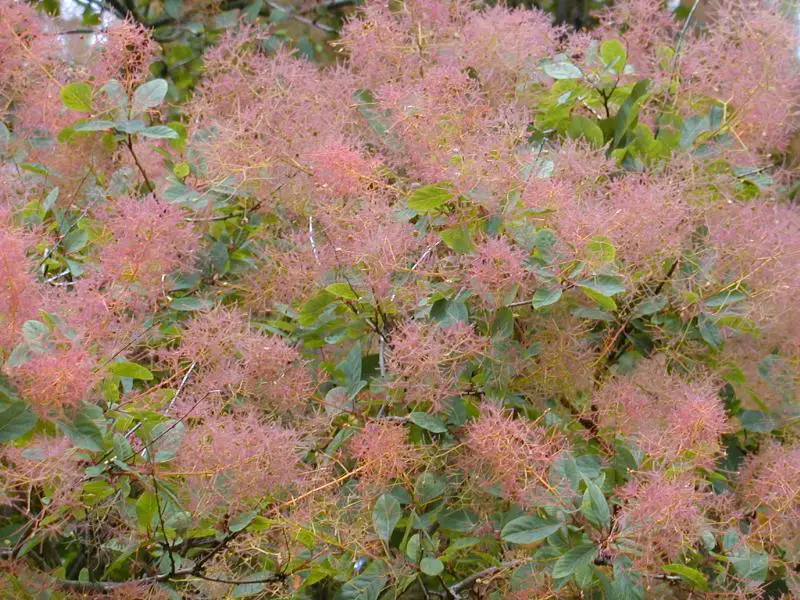
Smoke Bush is a large deciduous shrub admired for its dramatic, smoky-pink to purple flower clusters that resemble puffs of smoke, appearing in early to mid-summer. These “smoke” plumes persist well into the season and pair beautifully with its colorful foliage, which ranges from deep green to rich burgundy or purple, depending on the cultivar.
Adaptable to USDA zones 5 through 9, Smoke Bush thrives in full sun and well-drained soil. It is a tough and low-maintenance plant that tolerates heat, drought, and poor soils once established. Its unique floral display and foliage color make it a standout focal point in landscape designs.
For best appearance, prune in late winter or early spring to shape or rejuvenate the plant. Cutting back hard can encourage more vibrant foliage and a bushier form. Smoke Bush requires minimal watering and care, making it a reliable ornamental shrub for long-lasting summer interest.
Butterfly Magnolia (Magnolia virginiana)
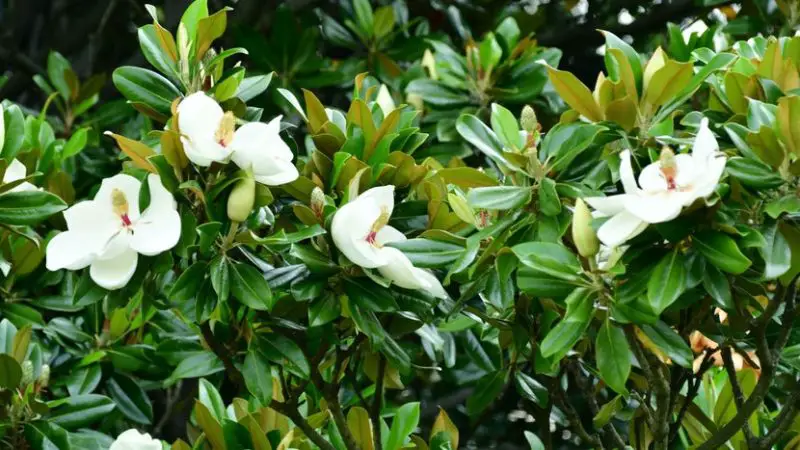
Butterfly Magnolia, or Sweetbay Magnolia, is a graceful, deciduous to semi-evergreen shrub or small tree known for its creamy white, lemon-scented flowers that bloom in late spring and continue sporadically into summer. The flowers are cup-shaped and attract pollinators like bees and butterflies. Its foliage is glossy green on top and silvery beneath, providing elegant contrast even when not in bloom.
Thriving in USDA zones 5 through 9, Magnolia virginiana grows best in full sun to partial shade and moist, slightly acidic soil. It is tolerant of wet conditions and is often found near streams or in low-lying garden areas. In warmer zones, it may retain its leaves through winter.
Minimal pruning is needed, though shaping after flowering can help maintain a tidy appearance. Water regularly during dry spells, especially in the first few years. Mulching helps preserve moisture and regulate soil temperature, making Butterfly Magnolia a beautiful and fragrant choice for summer gardens.
Buttonbush (Cephalanthus occidentalis)
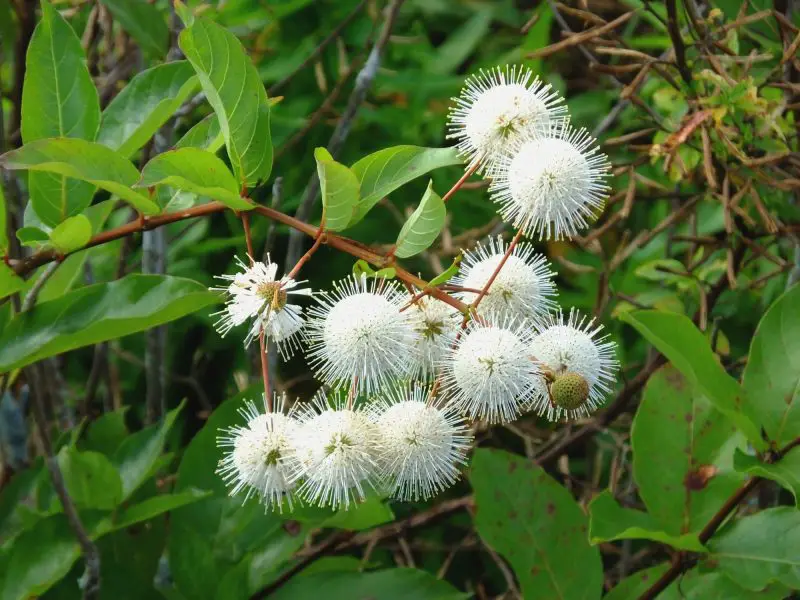
Buttonbush is a unique deciduous shrub recognized for its spherical, pincushion-like white flowers that bloom from early to mid-summer. The fragrant blooms attract a variety of pollinators, especially butterflies, bees, and hummingbirds. Its glossy green leaves provide a lush backdrop, and in fall, the plant often develops attractive seed heads and yellow foliage.
It thrives in USDA zones 5 through 10 and naturally grows in wet areas such as swamps, riverbanks, and rain gardens. This moisture-loving plant prefers full sun to partial shade and tolerates wet or poorly drained soils better than many other shrubs. It’s an ideal addition to water features or low-lying parts of a landscape.
Buttonbush requires minimal care once established. Pruning can be done in late winter to shape the plant or remove older wood. Consistent watering is key, especially in drier conditions. Its tolerance for water makes it especially valuable in ecological or native plant gardens.
Japanese Kerria (Kerria japonica ‘Pleniflora’)
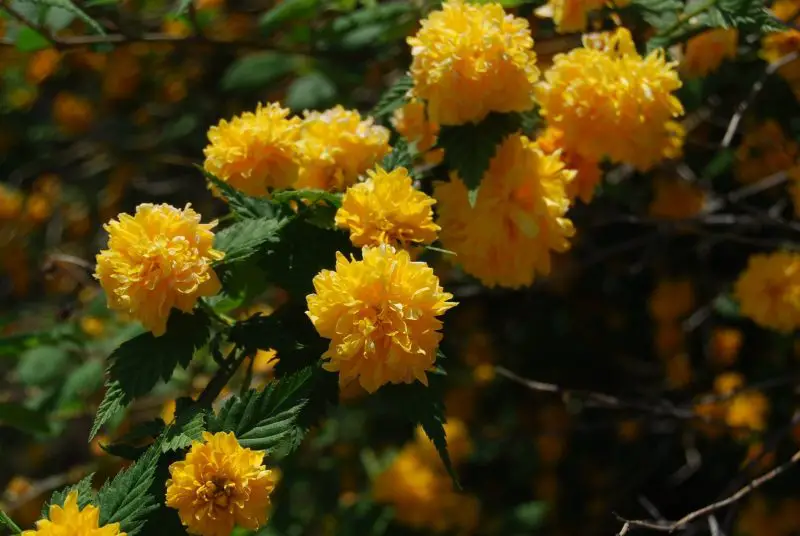
Japanese Kerria ‘Pleniflora’ is a cheerful, deciduous shrub noted for its bright yellow, double-petaled blooms that appear in late spring and may rebloom sporadically throughout summer. Its arching green stems remain attractive even in winter, adding year-round visual interest to the landscape.
Hardy in USDA zones 4 through 9, this shrub thrives in full sun to partial shade and well-drained soil. While it prefers some protection from harsh afternoon sun in hotter regions, it is otherwise tolerant of a variety of growing conditions, including drought once established.
Pruning immediately after the main bloom encourages a second wave of flowers and keeps the plant well-shaped. Japanese Kerria spreads by suckers, so occasional thinning may be necessary to control its size. It’s an excellent choice for woodland edges, cottage gardens, or informal hedges.
Rock Rose (Cistus spp.)
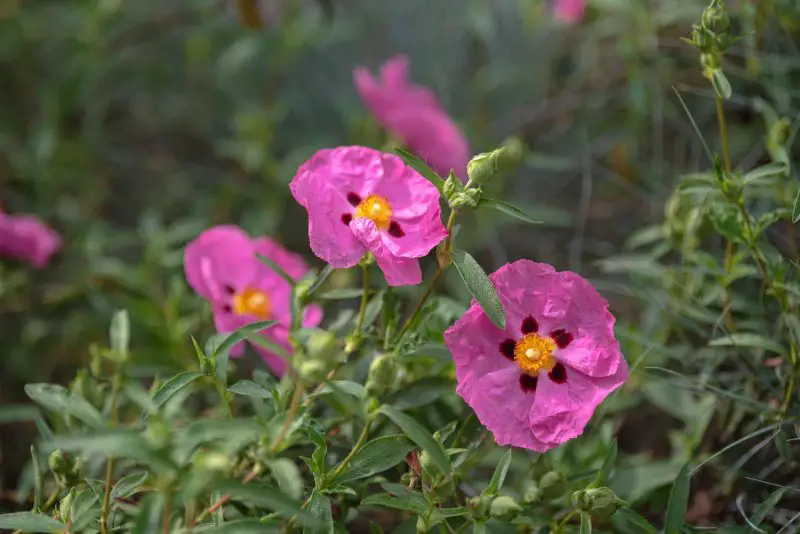
Rock Rose is a drought-tolerant evergreen shrub appreciated for its delicate, papery flowers that bloom profusely in early summer and continue sporadically through the season. Flowers appear in shades of pink, white, or lavender, each lasting only a day, but blooming continuously on new growth. The gray-green foliage adds texture and is resistant to deer.
Best suited to USDA zones 8 through 10, Rock Rose thrives in full sun and poor, rocky, or sandy soils with excellent drainage. It’s commonly used in Mediterranean-style gardens or xeriscapes due to its heat and drought resistance.
Little maintenance is required beyond occasional pruning to shape the plant after flowering. Overwatering or heavy soils can cause root rot, so it’s best planted in elevated or well-drained spots. Rock Rose makes a beautiful, easy-care addition to dry gardens or slopes.
Indian Hawthorn (Rhaphiolepis indica)
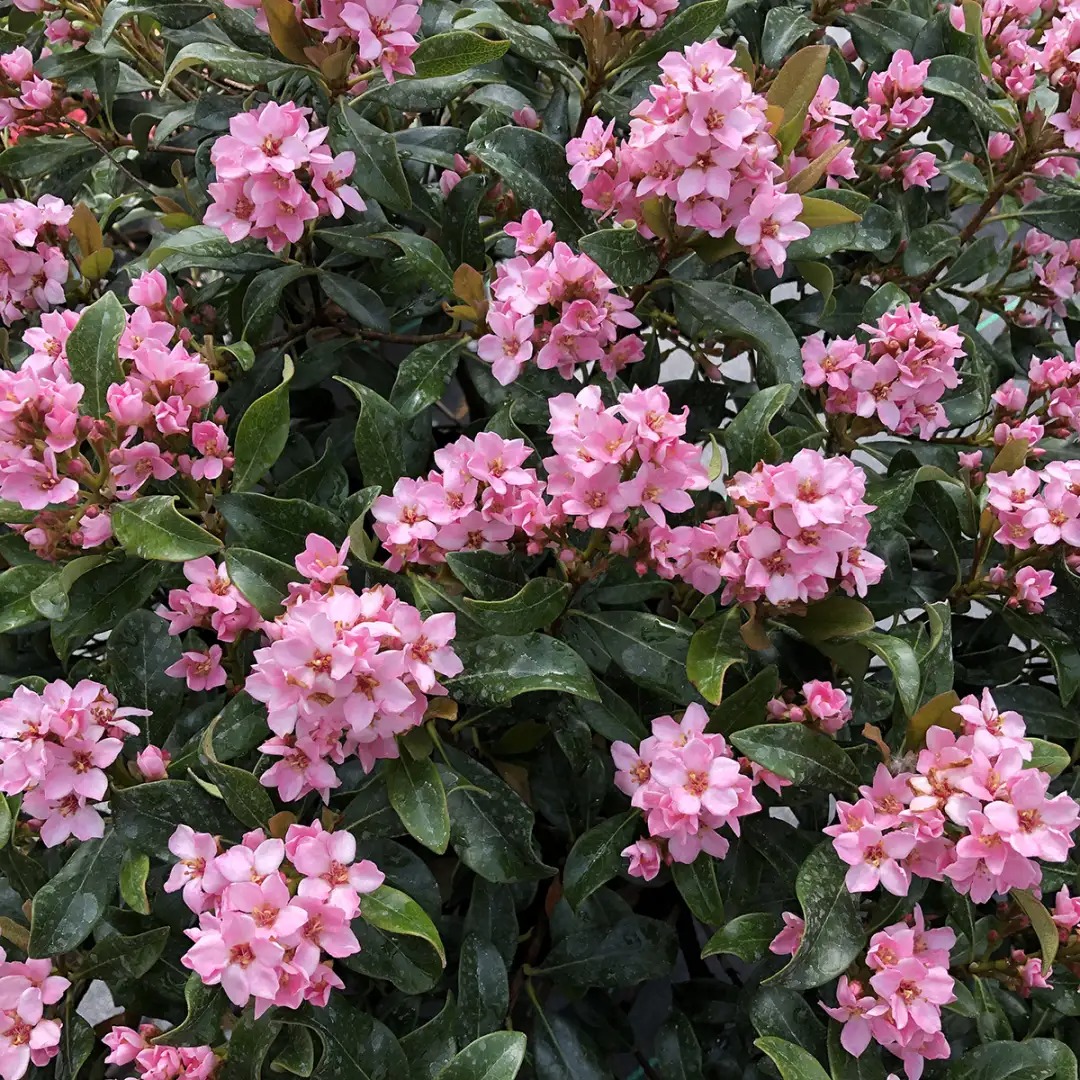
Indian Hawthorn is an evergreen shrub prized for its tidy, rounded form and clusters of fragrant pink or white flowers that bloom in spring and often reappear sporadically through summer. Its dark green, leathery leaves provide year-round appeal, and blue-black berries attract birds in the fall.
It grows well in USDA zones 8 through 11, preferring full sun to partial shade and well-drained soils. Indian Hawthorn is highly tolerant of salt spray, drought, and urban pollution, making it a popular choice for coastal gardens, foundations, and low hedges.
Indian Hawthorn needs minimal pruning to maintain shape and blooms best with ample sunlight. Watering is moderate once established, and it benefits from mulching and light fertilization in early spring. Disease-resistant cultivars are recommended to avoid fungal issues in humid climates.
Flowering Quince (Chaenomeles spp.)
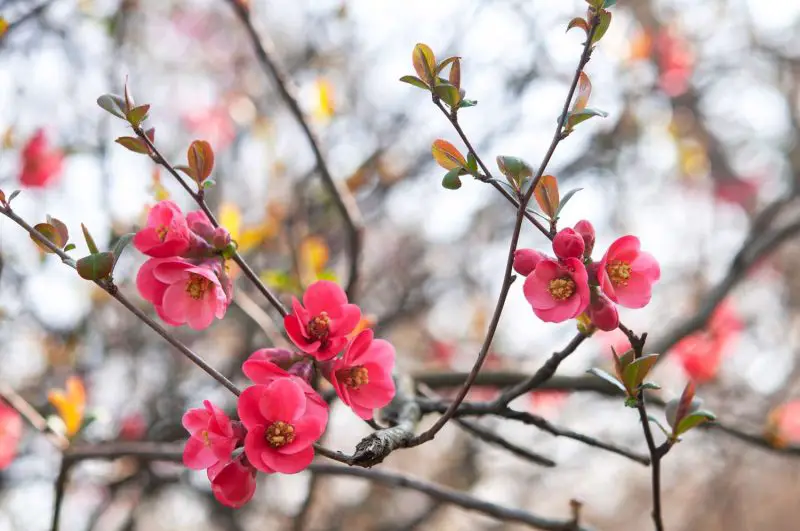
Flowering Quince is a deciduous shrub known for its early spring blooms in vivid shades of red, pink, orange, or white, and select cultivars such as ‘Double Take’ may rebloom lightly during summer. Its thorny branches and dense growth make it an excellent barrier or hedge plant, while the showy blooms provide a burst of seasonal color.
It grows well in USDA zones 5 through 9 and prefers full sun to partial shade. Flowering Quince is adaptable to a variety of soils, including clay, as long as there is good drainage. Once established, it is drought-tolerant and resistant to deer.
Minimal care is needed beyond light pruning after the main spring bloom to encourage summer rebloom and control size. Some varieties produce small, edible fruits in fall. This shrub’s resilience and ornamental value make it a versatile choice for low-maintenance gardens.
Bottlebrush (Callistemon spp.)
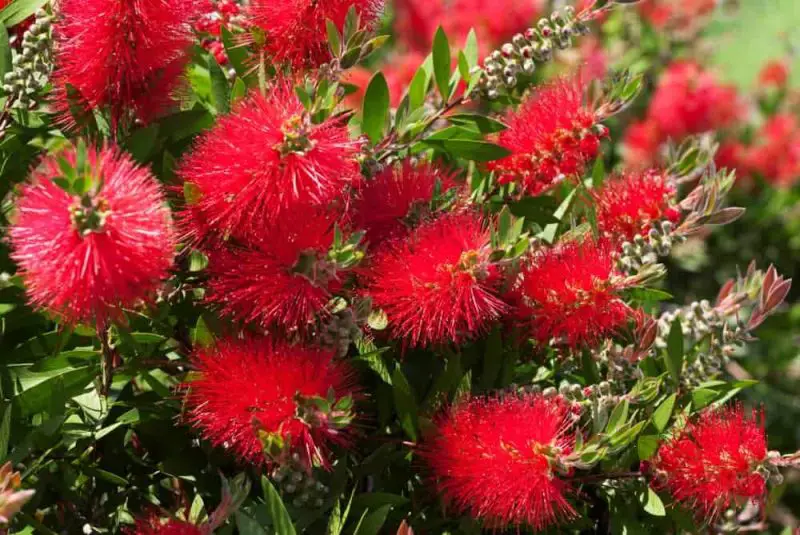
Bottlebrush shrubs are striking ornamental plants named for their cylindrical, brush-like flowers that resemble bottle cleaners. These vivid red, crimson, or pink flower spikes bloom from late spring through summer and occasionally into fall, attracting hummingbirds and pollinators. The evergreen foliage is narrow and aromatic, adding visual and sensory appeal.
Native to Australia, Bottlebrush thrives in USDA zones 8 through 11, where winters are mild. It grows best in full sun and well-drained soil, and it tolerates drought once established. It can be grown as a shrub or trained into a small tree depending on the species and pruning practices.
To maintain shape and encourage repeat blooms, light pruning after flowering is recommended. Avoid overwatering, especially in humid regions, as it prefers slightly dry conditions. Bottlebrush is a standout choice for Mediterranean gardens, coastal landscapes, and pollinator-friendly borders.
Bush Cinquefoil (Dasiphora fruticosa)
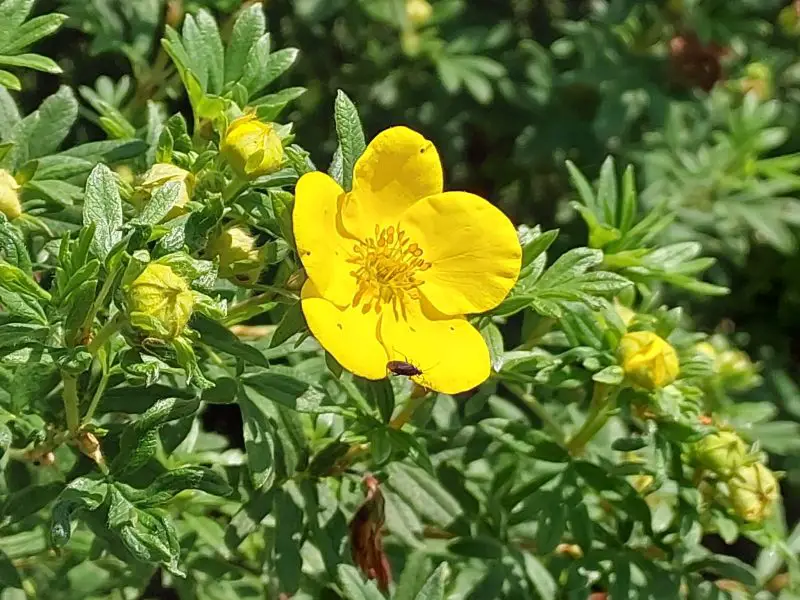
Bush Cinquefoil is a compact deciduous shrub known for its cheerful, buttercup-like flowers that appear in shades of yellow, white, pink, or orange. These blooms persist from late spring through the entire summer and sometimes into early fall, making it a valuable long-season bloomer. Its fine-textured, dark green foliage adds to its charm.
It grows well in USDA zones 2 through 7 and is highly tolerant of cold climates. Bush Cinquefoil thrives in full sun and prefers well-drained soils, including sandy or rocky types. It is often used in mass plantings, borders, and low-maintenance landscapes due to its toughness.
This shrub requires little care beyond occasional pruning to maintain a neat shape and promote fresh blooms. Drought-tolerant and deer-resistant, it is ideal for gardeners seeking a resilient flowering shrub with reliable performance throughout the growing season.
Bush Morning Glory (Ipomoea carnea)
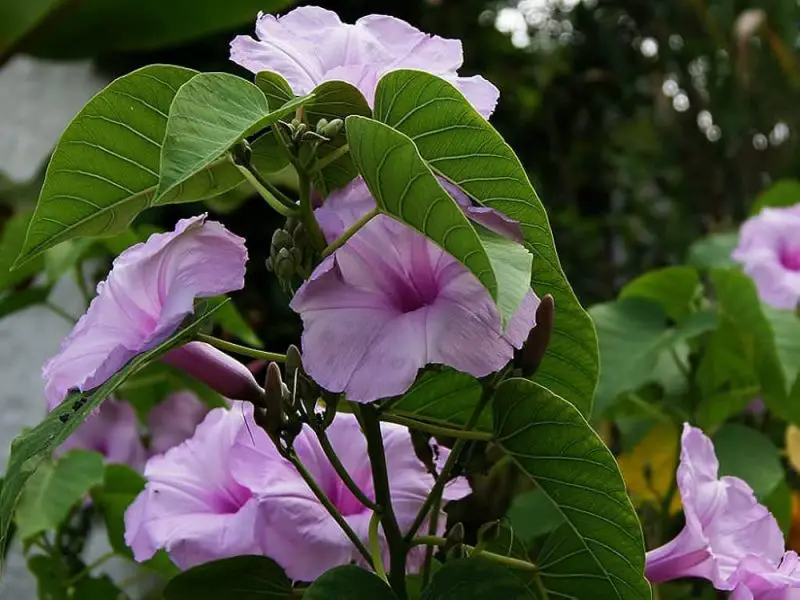
Bush Morning Glory is a fast-growing semi-woody shrub that produces large, trumpet-shaped, lavender-pink blooms throughout the summer. Unlike its vining cousins, this species forms a rounded, bushy habit and adds a tropical flair with its lush foliage and prolific flowering.
This plant grows best in USDA zones 8 through 11, thriving in full sun and moist, well-drained soil. It can be grown as a perennial in frost-free areas or treated as an annual in colder climates. It prefers warm, sunny locations and is often used for screening or background planting.
To keep Bush Morning Glory healthy and floriferous, provide regular watering during dry periods and prune lightly to encourage denser growth. It’s important to note that while beautiful, it can spread quickly in some regions and may need to be managed to prevent invasiveness.
Chaste Tree (Vitex agnus-castus)
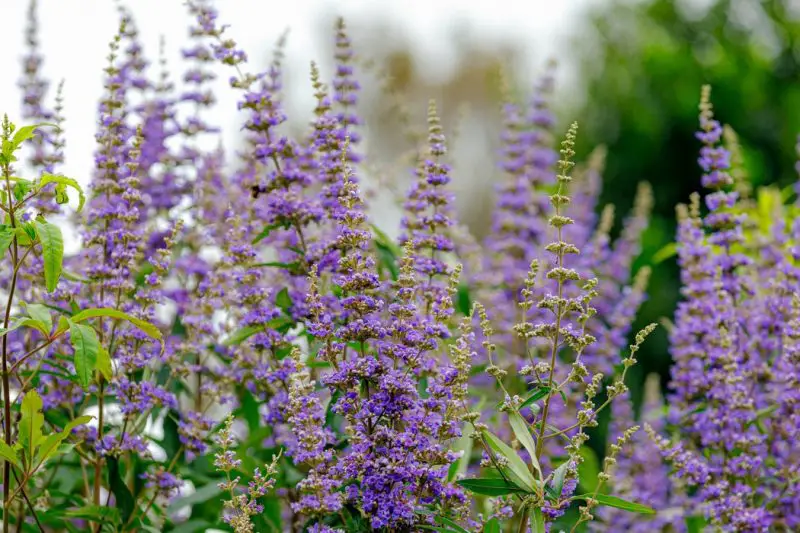
Chaste Tree, often grown as a large shrub or small multi-stemmed tree, is valued for its aromatic foliage and spiky clusters of violet-blue, pink, or white flowers that bloom from early summer through late summer. These blooms attract butterflies, bees, and hummingbirds, making it a pollinator favorite.
Best suited for USDA zones 6 through 9, this plant thrives in full sun and well-drained soil. It is drought-tolerant and performs especially well in hot, dry climates. In colder regions, it may die back to the ground in winter and regrow in spring, functioning as a perennial shrub.
To encourage a fuller form and abundant flowering, prune it in early spring. It requires minimal maintenance and is an excellent choice for xeriscaping, wildlife gardens, or as a striking focal point in sunny borders.
Dwarf Pomegranate (Punica granatum ‘Nana’)
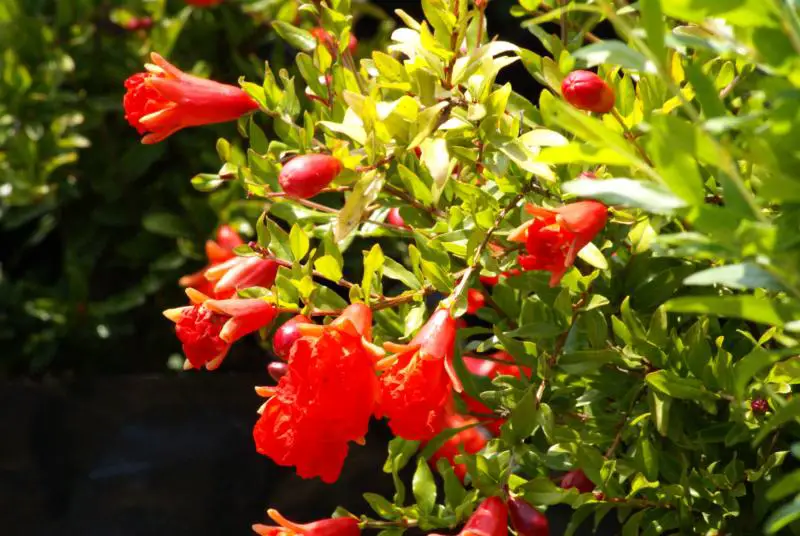
Dwarf Pomegranate is a compact deciduous or semi-evergreen shrub known for its vibrant orange-red flowers that bloom from late spring through summer. Though its fruit is much smaller than that of standard pomegranates, it is often used ornamentally or for small edible harvests. The glossy green foliage turns golden in fall.
Ideal for USDA zones 7 through 11, ‘Nana’ thrives in full sun and well-drained soil. It’s a popular choice for containers, patio gardening, and small landscape spaces. In cooler zones, it can be overwintered indoors or grown as a seasonal accent.
Minimal care is required beyond occasional pruning to shape the plant and encourage new growth. It tolerates heat and drought well once established and is resistant to many common pests. This versatile shrub is both beautiful and practical in warm-climate gardens.






